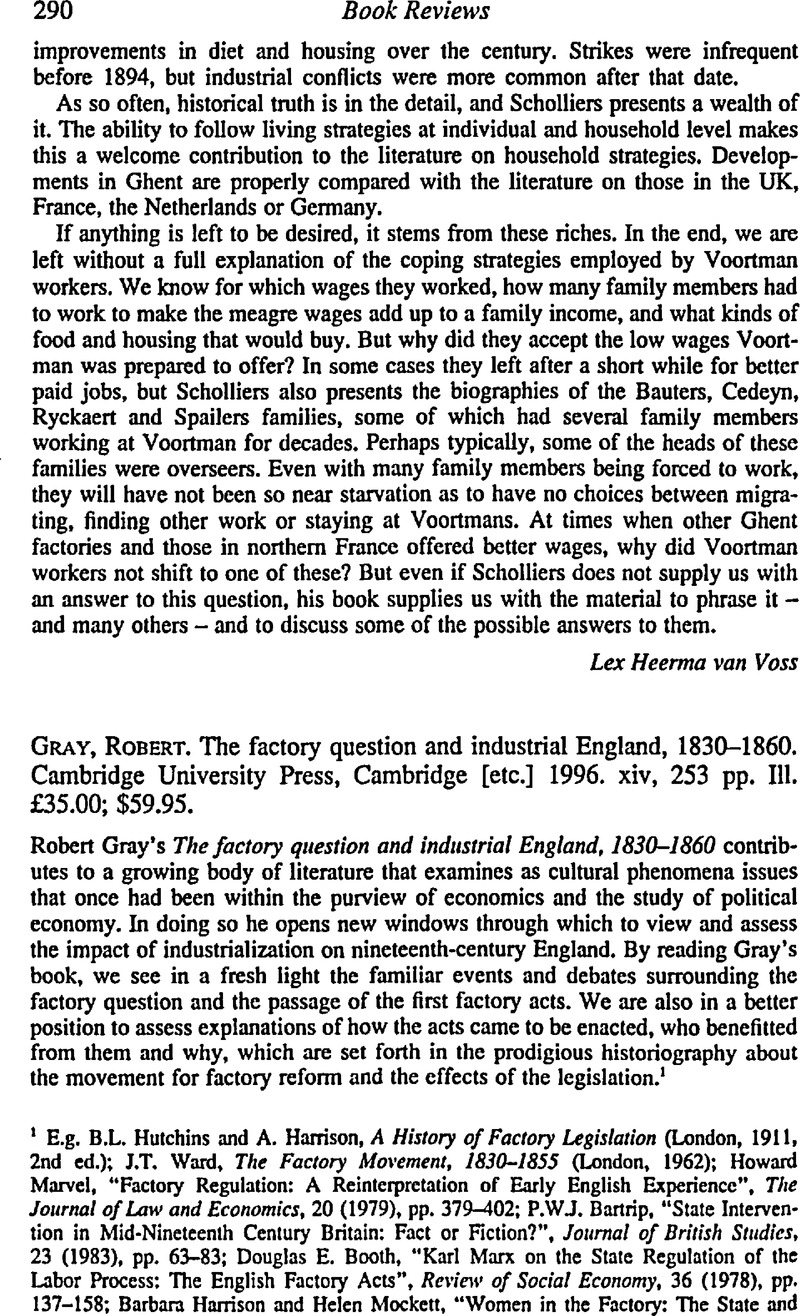No CrossRef data available.
Article contents
Robert Gray. The factory question and industrial England, 1830–1860. Cambridge University Press, Cambridge [etc.] 1996. xiv, 253 pp. Ill. £35.00; $59.95.
Published online by Cambridge University Press: 20 February 2009
Abstract

- Type
- Book Reviews
- Information
- Copyright
- Copyright © Internationaal Instituut voor Sociale Geschiedenis 1997
References
1 Eg. Hutchins, B. L. and Harrison, A., A History of Factory Legislation (London, 1911, 2nd ed.)Google Scholar; Ward, J. T., The Factory Movement, 1830–1855 (London, 1962)CrossRefGoogle Scholar; Marvel, Howard, “Factory Regulation: A Reinterpretation of Early English Experience”, The Journal of Law and Economics, 20 (1979), pp. 379–402CrossRefGoogle Scholar; Bartrip, P. W. J., “State Intervention in Mid-Nineteenth Century Britain: Fact or Fiction?”, Journal of British Studies, 23 (1983), pp. 63–83CrossRefGoogle Scholar; Booth, Douglas E., “Karl Marx on the State Regulation of the Labor Process; The English Factory Acts”, Review of Social Economy, 36 (1978), pp. 137–158CrossRefGoogle Scholar; Harrison, Barbara and Mockett, Helen, “Women in the Factory: The State and Factory Legislation in Nineteenth-Century Britain”, in Jamieson, Lynn and Corr, Helen (eds), State. Private Life and Political Change (New York, 1990), pp. 137–162CrossRefGoogle Scholar; Valverde, Marianna, “‘Giving the Female a Domestic Turn’: The Social, Legal and Moral Regulation of Women's Work in British Cotton Mills, 1820–1850”, Journal of Social History, 21 (1988), pp. 619–634CrossRefGoogle Scholar; Lewis, Jane and Rose, Sonya O., “‘Let England Blush!’: State Protection of Women Workers in England, 1830–1914”, in Wikander, Ulla, Kessler-Harris, Alice and Lewis, Jane (eds). Protecting Women: Labor Legislation in Europe, the United States and Australia, 1880–1920 (Urbana, IL [etc.], 1995), pp. 29–62Google Scholar; Rose, Sonya O., Limited Livelihoods: Gender and Class in Nineteenth-Century England (Berkeley [etc.], 1992), ch. 3.CrossRefGoogle Scholar
2 See for example the debates in Past and Present: Stone, Lawrence, “History and Post-Modernism”, Past and Present, 131 (1991), pp. 217–218Google Scholar and responses by Joyce, Patrick and Kelly, Catriona in Past and Present, 131 (1991), pp. 204–213CrossRefGoogle Scholar, and responses by Stone, Lawrence and Spiegel, Gabrielle M. in Past and Present, 135 (1992), pp. 189–194CrossRefGoogle Scholar; Mayfield, David and Thome, Susan, “Social History and Its Discontents: Garelli Stedman Jones and the Politics of Language”, Social History, 17 (1992), pp. 165–188CrossRefGoogle Scholar; Lawrence, Jon and Taylor, Miles, “The Poverty of Protest: Gareth Stedman Jones and the Politics of Language – A Reply”, Social History, 18 (1993), pp. 1–15CrossRefGoogle Scholar; Joyce, Patrick, “The Imaginary Discontents of Social History: A Note of Response to Mayfield and Thome, and Lawrence and Taylor”, Social History, 18 (1993), pp. 81–85CrossRefGoogle Scholar; Joyce, Patrick, “The End of Social Histoiy?”, Social History, 20 (1995), pp. 32–54CrossRefGoogle Scholar; Eley, Geoff and Nield, Keith, “Starting Oven The Present, the Post-modem and the Moment of Social History”, Social History, 20 (1995), pp. 355–364CrossRefGoogle Scholar; and Jones, Garelli Stedman, “The Determinist Fix: Some Obstacles to the Further Development of the Linguistic Approach to History in the 1990s”, History Workshop Journal, 42 (1996), pp. 19–36.CrossRefGoogle Scholar
3 See, for example, ibid.
4 See especially Palmer, Bryan, Descent into Discourse: The Reification of Language and the Writing of Social History (Philadelphia, 1990).Google Scholar




